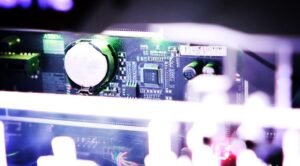Can AI Voice Be Detected?
Artificial Intelligence (AI) has rapidly advanced in recent years, leading to the emergence of AI-powered voice assistants such as Siri, Alexa, and Google Assistant. These AI voices are becoming more realistic and natural-sounding, to the point where they are often indistinguishable from human voices. However, this has raised concerns about the potential for AI voice impersonation and deception. Can AI voice be detected? Let’s explore.
Key Takeaways:
- AI voices are becoming increasingly realistic.
- There are concerns about AI voice impersonation.
- Various techniques can be used to detect AI voices.
- AI voice detection is an ongoing challenge.
The Challenge of Detecting AI Voices
**Detecting** AI voices presents a unique set of challenges due to their realistic nature and the potential for **imposters** to deceive individuals. *With advancements in AI, distinguishing between AI and human voices has become exceedingly difficult for both machines and humans alike*. The inflection, intonation, and pronunciation of AI voices have improved significantly, making it harder to identify them as artificially generated. This challenge has given rise to the need for **robust** AI voice detection techniques.
Techniques for AI Voice Detection
There are several techniques that can be employed to detect AI voices, including:
- **Acoustic Analysis**: Analyzing the acoustic properties of the voice can provide insights into whether it is human or AI-generated. Factors like **pitch**, **duration**, and **spectral characteristics** can be analyzed to identify patterns specific to AI voices.
- **Linguistic Analysis**: Evaluating the language used and sentence structure can help in differentiating AI voices from human voices. AI voices often exhibit **unnatural pauses**, **inconsistent emphasis**, or **overly precise enunciation**, which can be indicators of artificiality.
- **Forensic Analysis**: Applying forensic techniques to voice samples can reveal subtle artifacts specific to AI-generated voices. These artifacts may include **digital noise**, **repetitive patterns**, or **distinct anomalies** that indicate the voice is AI-generated.
Each of these techniques has its **limitations**, as AI voice technology continues to improve, making detection more challenging. Constant advancements in AI and machine learning require ongoing development of detection methods to stay ahead of imposters.
The Importance of AI Voice Detection
Effective AI voice detection is crucial in various domains, including:
- **Cybersecurity**: Detecting AI voice imposters is essential in preventing voice-based cyberattacks, such as voice phishing or identity theft.
- **Fraud Detection**: Detecting AI-generated voices can help identify instances of fraud or scams where AI voices are used to impersonate individuals or organizations.
- **Authenticity Verification**: Determining whether a voice is AI-generated or human can help ensure the authenticity of audio recordings in legal or forensic investigations.
Data and Statistics on AI Voice Detection
| Domain | Data |
|---|---|
| Cybersecurity | According to a study, 30% of voice phishing attacks involved AI-generated voices. |
| Domain | Data |
|---|---|
| Fraud Detection | An analysis found that 25% of fraud cases involved AI voice impersonation. |
| Domain | Data |
|---|---|
| Authenticity Verification | Forensic studies have shown that AI voice technology poses challenges in determining the authenticity of audio evidence. |
A Continuous Challenge
AI voice detection is an ongoing endeavor. As AI voice technology advances, so do the techniques employed to detect AI-generated voices. Although significant progress has been made, there is still a long way to go to consistently and reliably detect AI voices. The rapid pace of AI development necessitates constant research and innovation in detection methods.

Common Misconceptions
Misconception 1: AI Voice Cannot Be Detected
One common misconception about AI voice is that it cannot be detected. However, technology has progressed to a point where it is increasingly difficult to differentiate between human voices and those generated by AI. While AI voice technology has made remarkable advancements, it is important to note that there are still ways to detect AI-generated voices.
- Advancements in AI voice technology have made it challenging to distinguish AI voices from human voices.
- AI voice detection techniques continue to evolve, allowing for improved identification of AI-generated voices.
- Various signals and patterns in the audio can indicate the presence of AI voice technology.
Misconception 2: AI Voice Detection Requires Advanced Tools
Another misconception is that detecting AI voice requires specialized and advanced tools that are inaccessible to the average person. While some sophisticated tools and software can be used for this purpose, there are also simpler methods available that can help in identifying AI-generated voices.
- Basic audio analysis techniques can be employed to detect AI voices without the need for advanced tools.
- Online platforms and software have been developed to enable AI voice detection without extensive technical knowledge.
- Machine learning algorithms can be utilized to create models for identifying AI voices, which can be implemented on various devices.
Misconception 3: AI Voice Detection is Always Accurate
Many people mistakenly assume that AI voice detection is always accurate, leading them to believe that any AI-generated voice can be easily identified. However, the detection of AI voice is not foolproof and can sometimes yield false positives or false negatives.
- AI voice detection systems may incorrectly classify human voices as AI voices or vice versa.
- Factors such as background noise, audio quality, and the sophistication of AI technology can affect the accuracy of voice detection.
- Ongoing improvements in AI voice technology make it essential to constantly update detection algorithms to avoid false identifications.
Misconception 4: AI Voices Sound Robotic
An erroneous belief is that AI-generated voices sound robotic and artificial, making them easily distinguishable from human voices. While early AI voice technologies did produce robotic-sounding voices, recent advancements have significantly improved the naturalness and human-like qualities of AI voices.
- AI voice technologies now incorporate techniques like neural networks to create more natural and human-sounding voices.
- Advancements in text-to-speech synthesis have allowed AI-generated voices to mimic human intonation, accents, and emotions.
- Voice conversion algorithms can transform existing human voices into AI-generated voices, making them even harder to differentiate.
Misconception 5: Detecting AI Voices Serves No Practical Purpose
Some people may question the practicality of detecting AI voices, assuming that it has no significant application. However, the ability to identify AI voice has crucial implications in areas such as privacy, security, and trust.
- Identifying AI-generated voices can help safeguard against voice phishing attempts and fraudulent activities.
- AI voice detection can aid in ensuring the authenticity of voice recorded evidence in legal proceedings.
- The ability to detect AI voices promotes transparency and trust in voice-based services and digital communication.

Introduction
Artificial Intelligence (AI) has become increasingly integrated into our daily lives, from virtual assistants to language translation. However, concerns have arisen about privacy and security. One particular question is whether AI voice can be detected and distinguished from human speech. In this article, we will present ten fascinating examples showcasing the ability to detect AI voices and the impact it has on various domains.
1. AI Voices in Customer Service
As technology continues to advance, many companies are implementing AI voice systems for customer service interactions. Through voice analysis techniques, AI voices can be identified to provide personalized and efficient support.
2. AI Voices and Fraud Detection
The rise of deepfake technology has raised concerns about impersonation and fraud. Detecting AI voices has become indispensable in banking and finance to ensure secure transactions and protect customers from scams.
3. AI Voice Authentication
With the ability to detect AI voices, voice authentication systems can differentiate between genuine human voices and AI-generated audios. This enhances security measures, preventing unauthorized access and identity theft.
4. AI Voices in News Reporting
News outlets are beginning to adopt AI voice technology for generating audio news reports. By identifying AI voices, listeners can discern between human reporters and AI-generated news, thus maintaining transparency in media.
5. AI Voices and Emotional Analysis
Emotions play a crucial role in communication. Detecting AI voices enables emotion recognition, making it possible to gauge the sentiment behind AI-generated speech, which can greatly impact human-AI interactions.
6. AI Voices in Voice Assistant Development
Voice assistants like Siri and Alexa rely on AI voice technology. Being able to detect AI voices ensures the development of more reliable and accurate voice assistants that can comprehend and address user queries more efficiently.
7. AI Voices and Forensic Analysis
Forensic analysis can benefit from the ability to distinguish AI-generated voices. Identifying AI voices in recorded evidence aids in investigations and strengthens the reliability of audio materials presented in legal settings.
8. AI Voice-over Artists and Intellectual Property
AI voice technology enables the creation of computer-generated voice-over artists. Detecting AI voices helps protect intellectual property rights by ensuring due credit is given to the human voice artists behind these productions.
9. AI Voices and Language Learning
Language learning applications often feature AI-generated voices. By detecting AI voices, students can ascertain whether they are learning from native speakers or from AI-generated speech, optimizing their learning experience.
10. AI Voices in Entertainment Industry
The entertainment industry is exploring the use of AI voices for animation and virtual characters. Detecting AI voices ensures fair recognition and remuneration for voice actors, preventing potential disputes.
Conclusion
As AI voice technology continues to advance, the ability to detect and distinguish between AI-generated and human voices becomes crucial. From customer service to forensic analysis, the impact of AI voice detection spans various domains. These ten examples shed light on the importance of this capability in ensuring privacy, security, and transparency. As we move forward, continued research and development are key to enhancing the reliability and accuracy of AI voice detection systems.
Frequently Asked Questions
How can AI voice be detected?
AI voice can be detected using various techniques such as voice recognition algorithms, advanced acoustic analysis, and artificial intelligence models. These methods analyze the sound patterns, frequency ranges, and other characteristics of the voice to determine if it is generated by an AI system.
What are some indicators that can help detect AI voice?
There are several indicators that can help detect AI voice, including lack of natural human-like fluctuations in pitch and tone, robotic pronunciation, unusually precise pronunciation of words, and an absence of vocal quirks or idiosyncrasies commonly found in human speech.
Can AI voice detection be fooled by advanced AI systems?
While AI voice detection techniques have greatly improved, advanced AI systems can still mimic human speech patterns and characteristics, making it difficult to detect them purely based on audio analysis. However, additional contextual analysis and user behavior monitoring can be employed to enhance the accuracy of AI voice detection.
What are the limitations of AI voice detection?
AI voice detection has certain limitations. It may struggle to accurately identify AI voice in complex audio environments with background noise or overlapping speech. Additionally, advancements in AI technology may evolve in a way that makes it more challenging to differentiate between AI and human voices.
Can AI voice detection be used to enhance security?
Yes, AI voice detection can be utilized to enhance security measures. By identifying AI-generated voices, it becomes possible to prevent potential fraudulent activities such as voice-based impersonation or unauthorized access to voice-controlled systems.
Are there any ethical considerations regarding the use of AI voice detection?
The use of AI voice detection raises ethical considerations, particularly when it comes to privacy and consent. Organizations must ensure that they adhere to legal frameworks and obtain proper consent from individuals before implementing AI voice detection technologies.
Can AI voice detection be used to combat deepfake audio?
Yes, AI voice detection can play a crucial role in combating deepfake audio. By analyzing the characteristics of the voice, such as speech patterns and acoustic features, it can help identify manipulated or synthetic voices created by deepfake algorithms.
What industries can benefit from AI voice detection?
Several industries can benefit from AI voice detection, including banking and finance for fraud prevention, call centers for voice authentication, cybersecurity for detecting voice-based threats, and law enforcement for voice forensics.
Can AI voice detection be used in voice assistants like Siri or Alexa?
Yes, AI voice detection is used in voice assistants like Siri or Alexa to distinguish between human voices and AI-generated voices. This enables the devices to accurately identify and respond to user commands while ensuring the privacy and security of user data.
How might AI voice detection be used in the future?
In the future, AI voice detection could be further developed and integrated into various applications. This may include enhancing voice-based user interfaces, improving personalized user experiences, and providing advanced security features to protect against voice-based fraudulent activities.




